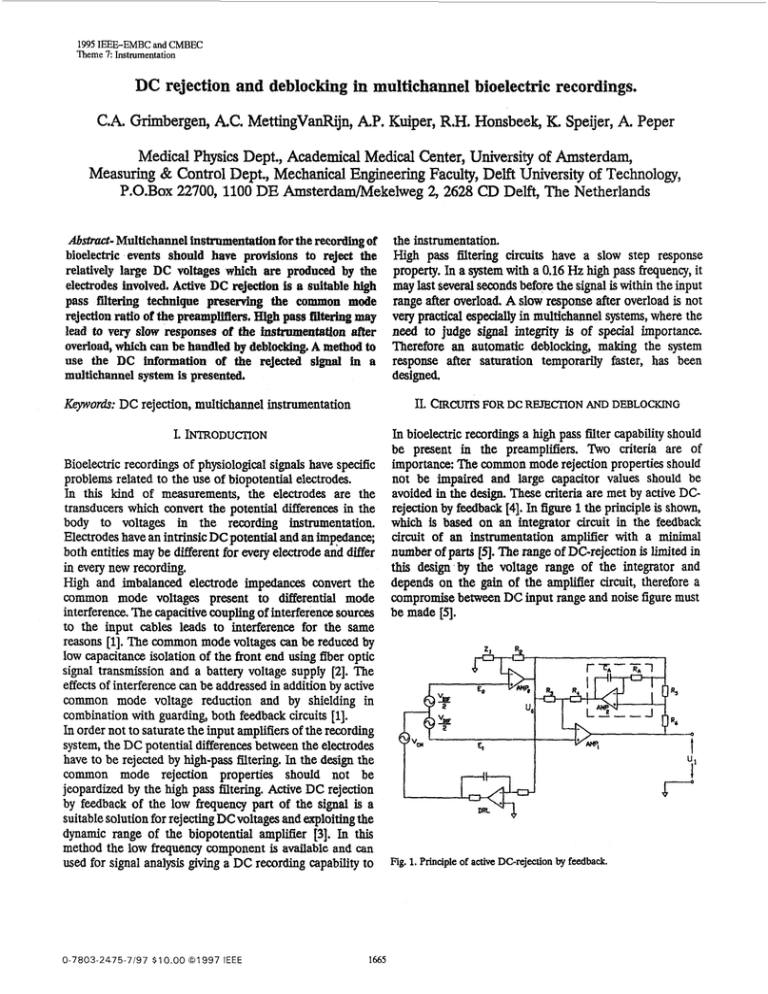Dc Rejection And Deblocking In Multichannel Bioelechic
advertisement

1995 IEEE-EMBC and CMBEC Theme 7:Instrumentation DC rejection and deblocking in multichannel bioelectric recordings. C.A. Grimbergen, A.C. MettingVanRijn, A.P. Kuiper, R.H. Honsbeek, K. Speijer, A. Peper Medical Physics Dept., Academical Medical Center, University of Amsterdam, Measuring & Control Dept., Mechanical Engineering Faculty, Delft IJniversity of Technology, P.O.Box 22700, 1100 DE Amsterdam/Mekelweg 2, 2628 CD Delft, The Netherlands &stmt- Multichannel instrumentation for the recordiig of bioelectric events should have provisions to reject the relatively large DC voltages which are produced by the electrodes involved. Active DC rejection is a suitable high pass filtering technique preserving the common mode rejection ratio of the preamplifiers. High pass filtering may lead to very sIow responses of the instrumentation after overload, which can be handled by deblocldng. A method to use the DC information of the rejected signal in a multichannel system is presented. &ywor&: DC rejection, multichannel Einstrumentation the instrumentation. High pass filtering circuits have a slow step response property. In a system with a 0.16 Hz high pass frequency, it may last several secondsbefore the signal is within the input range after overload. A slow response after overload is not very practical especially fin multichannel systems, where the need to judge signal integrity is of special importance. Therefore an automatic deblocking, making the system response after saturation temporarily faster, has been designed. 11. CIRCUrrS FOR DC RElECTION AND DEBLOCKING In bioelectric recordings a high pass filter capability should be present in the prleamplifiers. Two criteria are of Bioelectric recordings of physiological signals have specific importance: The commaln mode rejection properties should not be impaired and large capacitor values should be problems related to the use of biopotential electrodes. In this kind of measurements, the electrodes are the avoided in the design. These criteria are met by active DCtransducers which convert the potential differences in the rejection by feedback [4]1. In figure 1 the principle is shown, body to voltages in the recording instrumentation. which is based on an integrator circuit in the feedback Electrodes have an intrinsicDC potential and an impedance; circuit of an instrumentation amplifier with a minimal both entities may be different for every electrode and differ number of parts [5]. The range of DC-rejection is limited in this design by the voltage range of the integrator and in every new recording. High and imbalanced electrode impedances convert the depends on the gain of the amplifier circuit, therefore a common mode voltages present to differential mode compromise bemeen DC input range and noise figure must interference. The capacitive coupling of interference sources be made [SI. to the input cables leads to interference for the same reasons [l].The "man mode voltages can be reduced by low capacitance isolation of the front end using fiber optic signal transmission and a battery voltage suppIy [2]. The effects of interference can be addressed in addition by active *S common mode voltage reduction and by shielding in combination with guarding, both feedback circuits [l]. R6 In order not to saturate the input amplifiers of the recording system, the DC potential differences between the electrodes t have to be rejected by high-pass filtering. In the design the common mode rejection properties should not be jeopardized by the high pass filtering. Active DC rejection by feedback of the low frequency part of the signal is a suitablesolution for rejecting DC voltages and exploitingthe dynamic range of the biopotential amplifier [3]. In this method the low frequency component is available and can used for signal analysis giving a DC recording capability to Fig. 1. Principle of active DC-rejection by feedback. I. INTRODUCTION 0 0-7803-2475-7197 $ 1 0.00 0 1 9 9 7 IEEE 1665 The output voltage of the integrator contains the low frequency part of the signal, although it will possess in general a different (i.e. smaller) gain. The integrator output signal may be used for transferring the low frequency component of the signal to the signal processing hardware. To this end the integrator output signal is low pass filtered with a comer frequency identical to that of the DC rejection circuit (see figure 2). Because of the low bandwidth of this signal component, the transfer can be performed with proportionally less samples. The acquisition of this low frequency component gives the instrumentation a DC recording capability. In the signal processing hardware this information may, after appropriate scaling, also be combined to a pseudo DC-measurement, in which the signal to noise ratio of the low frequency component will be lower than that of the rest of the signal. In any high pass filter there is a slow response to large disturbances in the signal like movement artifacts or other electrode related artefacts and connecting the inputs. The response time is dependent on the design but is typically 5 to ten times the time constant of the high pass filter (integrator time constant in the DCrejection circuit). Especially in a multichannel setup this may lead to impractical delays during electrode application or occasional electrode problems. To solve this a deblockingprovision has been designed which makes the @ne constant temporarily smaller during overload (see figure 2). The deblocking circuit is controlled by the output voltage being out of range, but control may also be manual. When the signal has reached the limits of its output range the time constant is switched to its original low value and the signal will adjust to the signal with DC-suppression. The deblocking is maintained for an additional hundred milliseconds to make the amplifier to start with a zero level at is output. t I between different electrodes. In general the DC-voltagedoes not possess information of the signal to be measured and wiII limit the range of the recording. Filtering the DC component will allow a larger gain to be used and consequently the AC-signal will be recorded with a better accuracy leading to a higher signal to noise ratio. Active DC rejection is a suitable implementation for high pass filtering in bioelectric recordings because common mode rejection properties are preserved and the use of large capacitors may be Circumvented. An additional advantage is that the low frequency component of the signal is also available and can be recovered from the DC rejection CirCuitIy. An important drawback of high pass filtering with a large time constant is the slow response of the recording circuitry to disturbances and after connection of the input signal. A deblocking provision may solve this problem and allow for a nearly continuous recording of valid data. Overload in any channel will be detected and displayed as a constant signal. High pass filtering may be avoided by increasing the dynamic range of the system to level at which both the DC and the AC component of the signal can be recorded with the same accuracy. Improvements in the quality of the analog and digital components may increase the dynamic range in the near future enabling the development of general recording hardware for DC recording of any electrophysiologicalsignal [6J. REFERENCES A. C.MettingVanRijn, A. Peper and C k Grimbergen, "High quality recording of bioelectric events. I: interference reduction, theory and practice," Med & BWL En& & Comput, vol. 28, pp. 389-397,1990. k C MettingVanRijn, A. Peper and C. k Grimbergen, "The isolation mode rejection ratio in bioelectricamplifiers,"lEEETruns. Biomed &g, BME-38,1154-1157,1991. G.H. Hamstra, k Peper and C. k Grimbergen, "Low-power,low-noise instnunentationamplifier for physiological signals.'' Med & BioL Eng & Comp. VoL 22, pp 272274,1984. A. C. MettingVanRijn, k Peper, C. k Grimbergen, ''High-quality recarding of bioelectric events. Part 2. A low-noise low-power multichannel ampmer design."Med & BWL Eng. & Cornpur)VoL29, pp 433-440,1991. A. C MettingVauRijn, k Peper, CA. Grimbergen, "A high pformance bioelectric amplifier with a minimal number of parts.", Med & BWL Ens & Comput VoL 32, p305-310,1994. C k Grimbergen, k C MettingVanFUjn, k Peper, "System configurations with e/D convmion for multichannel bioelectric recordings!', prom?& &r 16thAnn I . . Coni W E Eng m Med & BWL SOC,B-e, 996-997,1994. OTHER CIV"ELS r---- I Rg. 2. DC-rejection circuit with deblocking circuit and DC output. 111. DISCUSSION In bioelectric recordings high pass filtering is necessary in view of the potentially large DC-voltage which may exist 1666





